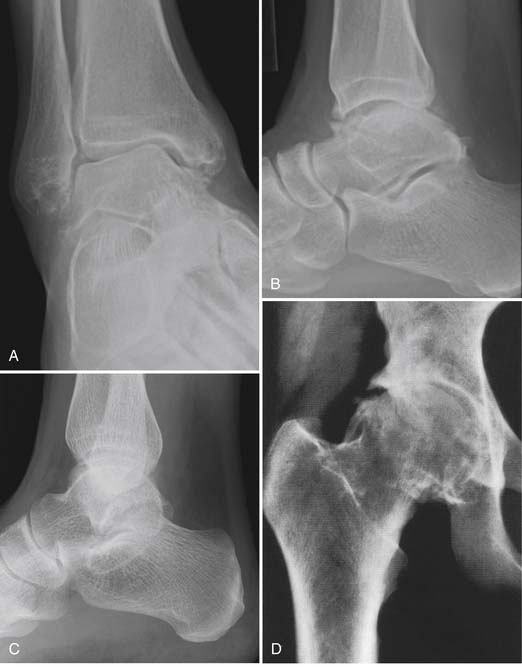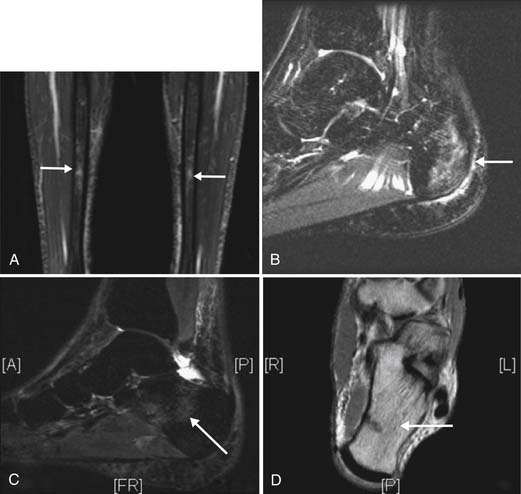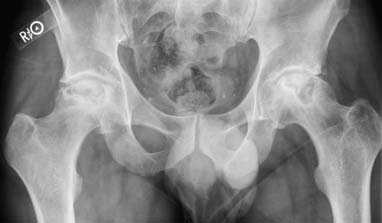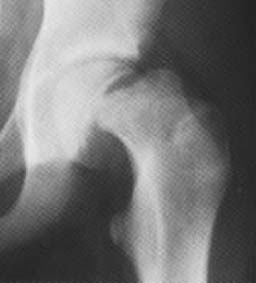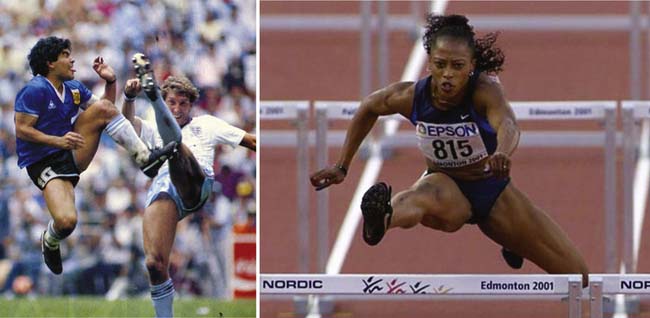Chapter 39 Musculoskeletal Disorders of the Lower Limb
Hip Tests
Faber or Patrick Test
The patient lies supine and the hip is flexed, abducted, and externally rotated with the ankle resting on the contralateral knee. The examiner applies pressure to the contralateral ilium and ipsilateral knee to further externally rotated the hip. The test is positive for sacroiliac joint pathologic findings if the patient’s buttock pain is reproduced. The test is positive for hip pathologic findings if the patient’s groin pain is reproduced.
Knee Tests
Rehabilitation Principles of Lower Limb Injury
Several terms are used throughout the chapter that might not be familiar to all readers. For the sake of clarity, we would like to first define some of these terms. First and foremost, the term kinetic chain refers to the model of human motion that analyzes and treats dysfunction along connected anatomic regions, rather than focusing only on the location of pain. This model recognizes that dysfunction in one anatomic region can cause dysfunction in other anatomic regions that are linked to the first region during motion. Treatment plans that address only the painful site, and ignore underlying pathologic conditions at other sites along the motion chain, have less chance of success than a treatment plan that restores proper function along the entire chain. Kinetic chain considerations are most relevant when discussing muscle and tendon pathologic conditions but should not be ignored when addressing bone and joint pathologic findings.
The term biomechanical deficit refers to any deficiencies in range of motion, flexibility, strength, endurance, or motor control. The term muscle imbalance refers to the divergence from normal function of different muscle groups that work as agonists or antagonists to stabilize a body part or create motion. Muscle imbalances often occur between muscles on the anterior versus posterior side of a joint, such as the hip flexors versus the hip extensors, or the medial versus lateral side of a joint, such as hip adductors versus hip abductors. Some authors have suggested that these types of muscle imbalances predispose to sports injuries.33,71,142
It is important to mention a precaution that should be taken into account when treating patients. It has been common practice to use nonsteroidal antiinflammatory drugs (NSAIDs) to treat musculoskeletal injuries to control pain and reduce inflammation. Evidence shows that NSAIDs can impair muscle healing by inhibiting the fusion of myogenic precursor cells, and this knowledge should be considered before prescribing these medications.101,132
Musculoskeletal Disorders of the Lower Limb
General Approach to Osteoarthritis in the Lower Limb
Plain films are the study of choice to assess for osteoarthritis. The radiologic hallmarks of osteoarthritis include decreased joint space, marginal osteophytosis, subchondral cyst formation, and subchondral sclerosis (Figure 39-1).88
Many treatment options are available for lower limb osteoarthritis. A patient can sometimes diminish symptoms simply by modifying activities. Switching from higher impact activities such as basketball to lower impact activities such as bicycling or swimming can decrease or eliminate joint pain.83,148 Ice, acetaminophen, and NSAIDs can all reduce joint pain. Glucosamine and chondroitin sulfate have shown mixed results for reducing pain in knee osteoarthritis.82,93,125,126,145 Strength training and aerobic exercise can improve joint control and decrease pain.113 Strategies aimed at reducing loads on joints include weight loss, cushioned shoes, and walking aids such as a cane.151 Intraarticular injection of anesthetic and steroid can be helpful both diagnostically and therapeutically.115,139 Recent evidence shows that bupivacaine in concentrations 0.5% or more is chondrotoxic, and it would seem judicious to avoid its use in joint injections.31 Injections of the foot, ankle, and hip joints are best performed under fluoroscopic guidance with contrast confirmation. Several investigations looking at knee osteoarthritis have concluded that intraarticular injections of hyaluronate relieve pain and improve function in patients with mild and moderate knee osteoarthritis.2,63,74,86 For patients with recalcitrant pain or severe functional limitations, arthroplasty can provide substantial improvement in pain and function.
Stress Reactions and Stress Fractures in the Lower Limb
Repetitive overload injuries to the bones of the lower limb are common in physically active individuals, especially those who participate in endurance activities such as distance running. In cases of repetitive stress, or in the setting of impaired bone metabolism, bone strain occurs on a continuum from “stress response” or “stress reaction” to overt stress fracture. Bone overload can occur in any location in the lower limb (Figure 39-2). The ability of bone to withstand repetitive forces without breaking down depends on several factors. The stronger the bone is before being subjected to repetitive loading, the better it is able to withstand the loads applied to it. Both intrinsic and extrinsic factors are important to consider in determining the risk for stress reactions or stress fractures. Intrinsic risk factors include poor dietary habits, altered menstrual status, and biomechanical abnormalities that do not allow for proper distribution of forces along the kinetic chain. Extrinsic factors can include hard training surfaces, training errors, and improper footwear and insoles.
Athletes report a greater frequency of disordered eating patterns than the general population, especially in sports emphasizing leanness.121 Individuals with disordered eating can have insufficient dietary intake of calories, protein, calcium, and other nutrients needed to achieve optimal bone quality. The triad of disordered eating, amenorrhea, and low bone density that occurs in athletic females is referred to as the female athlete triad. Restrictive eating behaviors increase the likelihood of stress fractures in women.14,15,46,105 Low caloric intake with negative protein balance has been hypothesized as one of the mechanisms for menstrual disturbances in female athletes.155 Evidence shows that menstrual and hormonal disturbances increase the risk of stress fracture and lead to premature bone loss, particularly at trabecular sites.64,103
Flexibility, although difficult to study, can play a role in fracture risk. Some studies have suggested that increased hip external rotation and decreased ankle dorsiflexion might increase the risk for stress fractures in certain populations.50,51,60
Skeletal alignment affects the amount of force absorbed by the foot, and how much force is transferred to proximal structures during ground contact. A rigid pes cavus foot is less able to absorb shock during and just after heel strike, and can transmit greater forces to proximal bones than a foot that is able to undergo normal pronation. Similarly, a pes planus foot does not allow the normal pronation mechanism to properly absorb forces. Either foot alignment can increase the risk of a stress fracture, the location of which can vary depending on the foot type and activity.91,134 Other studies looking at alignment have suggested that leg length discrepancy and increased Q angle can increase the risk of stress fracture.27
Although it is clear that training errors contribute to stress fractures, there is limited research identifying the contribution of various training components. Furthermore, appropriate training regimens vary greatly among individuals. Athletes should be encouraged to keep training logs documenting type of training, volume, intensity, and rest periods. A rapid increase in training volume and intensity often precedes a stress fracture, just as it might precede a muscle–tendon overload injury. Articles about training in military recruits have shown that elimination of running and marching on concrete, preentry physical conditioning, and inclusion of rest periods reduced stress fracture risk.54,130,131
Shoes and insoles can be an important component in minimizing stress fracture risk. Proper shoe fit that matches an individual’s foot type, as well as adequate support and shock absorption, is essential. Studies looking at the effect of insoles or other footwear modifications on the prevention of stress fractures have shown a reduction in the number of stress fractures by more than 50%.52,96,97
Imaging studies are not always necessary. A 6-week period of relative rest with nonimpact rehabilitation and alternative training methods such as pool running can be instituted. Imaging can be reserved for individuals who remain symptomatic and are unable to return to full activities. In these cases, or when definitive diagnosis is required sooner, the initial imaging study of choice is radiographs. It should be kept in mind, however, that plain films are relatively insensitive and detect less than 50% of stress fractures.75,76 When radiographs are normal but the suspicion for stress fracture remains high, advanced imaging studies are appropriate. Bone scans are sensitive for detecting stress fractures but lack anatomic definition. They can also remain positive long after symptoms have resolved. This limits the ability of bone scans to aid in return-to-sport decisions.138 Magnetic resonance imaging (MRI) provides excellent anatomic information and can be more useful in grading lesions and assessing soft tissue structures.6 At our institution, MRI is the study of choice to look for stress fractures. Computed tomography (CT) provides optimal definition of bony architecture.
Reduced muscle size and strength have been shown to predispose to stress fractures.59 In endurance events, muscle fatigue can increase the strain on bone.154 Muscle mass is important to build and maintain because the load placed on bone can be reduced at sites when muscles are better able to absorb repetitive impact.129 A strengthening program should begin immediately after a diagnosis of stress fracture is made. The exercises prescribed should not cause pain at the fracture site.
Inactivity has negative consequences on the cardiovascular system, metabolism, and skeletal muscle after even brief periods of rest. It is important that fitness be maintained in ways that avoid overloading the bone. The most common cross-training activities include cycling, swimming, water running, rowing, and Stairmaster. The more sport specific the cross-training, the better the carryover effect of the training. It is for this reason that deep water running has become so popular among runners with stress fractures. Studies have shown no significant differences in maximal oxygen uptake, anaerobic threshold, running economy, stride length, and 2-mile performance after 4 to 8 weeks of land versus deep water running training.38,58,153 In sports requiring specific skills, the neuromuscular adaptations are not easily duplicated with cross-training, and it is important to find appropriate ways to resume these isolated sport-specific skills as soon as possible.
Conditions of the Hip Region
Femoral Neck Stress Fractures
With femoral neck stress fractures, symptoms are often vague, and one should have a high index of suspicion to catch this diagnosis early and avoid complications such as displacement or avascular necrosis. If suspicion is present, an MRI should be obtained (Figure 39-3). Fractures on the tension side (lateral) are less common and require immediate surgical referral. Fractures on the compression side (medial) are more common. If the fracture line extends more than 50% of the width of the femoral neck, percutaneous fixation should be considered because the likelihood of displacement is higher.6,32,133 When the fracture line is less than 50% of the width of the femoral neck, strict non–weight-bearing status is necessary for about 4 to 6 weeks until the patient is pain free. This should be followed by functional rehabilitation with progressive weight-bearing over the next 4 to 8 weeks according to symptoms. If the athlete is not progressing as expected, additional radiologic evaluation should be considered.
Avascular Necrosis
Avascular necrosis, also called osteonecrosis, is the death of bone resulting from a lack of blood supply. This can lead to microfractures and eventually collapse of the bone. The femoral head is the most commonly affected location. Disruption of the normal blood supply to the femoral head can be caused by various conditions including trauma, high doses of corticosteroids, alcohol abuse, and systemic illness (such as diabetes, lupus, and sickle cell anemia).84 The severity of symptoms with avascular necrosis is usually related to the degree of articular surface disruption. Symptoms are similar to those experienced with hip osteoarthritis, including groin pain that increases with weight-bearing. Often there is limited motion and pain with internal rotation, flexion, and adduction of the hip. Radiographs can reveal sclerosis of the femoral head or, in severe cases, collapse of the femoral head (Figure 39-4). In mild cases, the plain films can be normal. MRI and CT can detect the condition in its earlier stages. Conservative treatment might include minimizing weight-bearing of the affected joint and use of pain medications. Once collapse occurs, joint replacement surgery is indicated.
Legg-Calvé-Perthes Disease
Legg-Calvé-Perthes disease is idiopathic osteonecrosis of the femoral head in children. It occurs most frequently in boys between the ages of 4 and 8 years. Because bone repair is relatively rapid in children, the prognosis is significantly better compared with adults with avascular necrosis. Signs of Legg-Calvé-Perthes disease in a child include limping and restriction in hip motion, especially hip abduction. The child might complain of groin or thigh pain. Healing can occur in children with revascularization of the femoral head and remodeling of the bone. The prognosis is better in younger children and those with milder involvement. In children under the age of 6 years, observation and use of an abduction brace to maintain the femoral head in a spherical state is reasonable. Osteotomy is sometimes performed in older children.85
Slipped Capital Femoral Epiphysis
The most common hip disorder in adolescents is slipped capital femoral epiphysis. Injury to the physeal plate of the proximal femur with medial displacement of the femoral head relative to the femoral shaft can be due to acute trauma or repetitive microtrauma. Slipped capital femoral epiphysis is rare in boys under age 11 years and girls under age 9 years, and is more common in overweight boys.85 There can be an association with hypothyroidism and renal osteodystrophy.48 Slipped capital femoral epiphysis is bilateral about 50% of the time.85 An adolescent with an acute slip typically presents with severe hip pain that is exacerbated with any motion. The individual tends to hold the hip flexed and externally rotated. Anteroposterior and lateral radiographs confirm the diagnosis(Figure 39-5). A mild slip can be treated conservatively.127 Otherwise, one attempt at closed reduction can be done. If this is unsuccessful, open reduction should be done. After reduction, gentle range of motion can be started within a few days, but weight-bearing is restricted for 4 to 6 weeks.127 After this period, gradually progressive strengthening and functional exercises can be advanced. Complications include nonunion, avascular necrosis of the femoral head, rotational deformity, and osteoarthritis.85,137
Hip Dislocation
Because of the depth of the acetabulum, dislocation of the femoral–acetabular joint requires significant trauma. In children, hip dislocation is more common than hip fractures. In adults, fractures of the acetabulum often accompany hip dislocations. Most commonly, the head of the femur dislocates posteriorly relative to the acetabulum.102 The patient with an acute posterior hip dislocation presents with severe hip pain and tends to hold the hip in flexion, internal rotation, and adduction. With the less common anterior dislocations, the hip is held in an extended, abducted, and externally rotated position.
On physical examination, there will be an obvious deformity. The patient will not tolerate range of motion or resistance testing because of pain. A complete neurologic examination should be performed to assess for lumbosacral plexopathy, sciatic neuropathy, and femoral neuropathy.92 One should always assess for associated injuries, in particular spine and ipsilateral knee trauma, which can be masked by hip pain. Radiographs are indicated to confirm the clinical diagnosis and look for associated injuries. Hip dislocations are an orthopedic emergency, and closed reduction under anesthesia should be performed as soon as possible. Postreduction radiographs are obtained to confirm anatomic alignment. At times, CT or MRI is obtained if further characterization of associated injuries is needed.
Surgery is indicated if attempts at closed reduction are unsuccessful. The surgical goals are to repair displaced or comminuted fractures and remove intraarticular loose bodies.36 Most clinicians recommend non–weight-bearing for 3 to 4 weeks, followed by protected weight-bearing for an additional 3 weeks.127 Gradually progressive rehabilitation can start a few days to a couple of weeks after reduction, depending on the patient’s comfort level and whether surgery was performed. The most concerning complications of hip dislocation include posttraumatic osteoarthritis and avascular necrosis, which occurs in up to 10% of patients.137 The risk of avascular necrosis increases with age, reduction delayed greater than 6 hours, and more severe trauma to the hip joint.
Labral Injuries
Acetabular labral tears are analogous to glenoid labral tears, with some notable exceptions. Patients with acetabular labral tears often present with painful catching of the hip, especially when the hip is at a particular angle.90 There might be a clear history of acute or repetitive trauma. Femoral–acetabular grind maneuvers might reproduce symptoms. Historical features and physical examination maneuvers are even less specific for acetabular labral tears than they are for glenoid labral tears. This might be because the hip is a larger, deeper joint with less sensitive innervation than the shoulder joint. Magnetic resonance arthrography with gadolinium contrast is the imaging study of choice to assess for these injuries (Figure 39-6). Definitive diagnosis is by arthroscopy or open surgery.
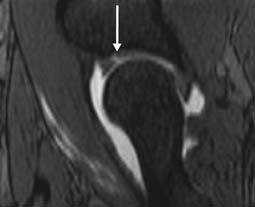
FIGURE 39-6 Gadolinium-enhanced sagittal magnetic resonance image of the hip, showing an anterior labral tear.
Treatments can include acetaminophen or NSAIDs, relative rest, intraarticular steroid injections, and surgical debridement or repair. The arthroscopic and open surgical approaches to labral injuries of the hip continue to evolve.20,21,39,69
Femoroacetabular Impingement Syndrome
In recent years, there has been greater attention given to the concept of femoroacetabular impingement. The condition is characterized by early contact during hip motion between skeletal prominences, limiting range of motion (particularly in flexion and internal rotation). Two types of impingement exist. Pincer impingement is the acetabular cause of impingement and is characterized by overcoverage of the femoral head. Cam impingement is the femoral cause and is due to an aspherical portion of the femoral head–neck junction. Currently, most authorities think that repetitive stress to these osseous prominences leads to chondral damage over time with resultant early osteoarthritis of the hip if the underlying cause of impingement is not addressed.47
Athletic Pubalgia and Sportsman’s Hernia
Athletic pubalgia and sportsman’s hernia refer to a spectrum of disorders that cause pain in the lower abdomen and groin. Pain generators can include overload of one or more of the lower abdominal muscles near the superior pubic ramus, a strain of the hip flexors and/or hip adductors, stress response or stress fracture of the pubic rami, and pubic symphysitis (Figure 39-7).8,44,45,68,87 A defect in the fascia of the lower anterior abdominal wall has also been described. Overload injury in this region is most commonly seen in football, soccer, and hockey.∗ There can be a delay in accurate diagnosis, and rehabilitation is often incomplete. Because symptoms of athletic pubalgia can easily become chronic, it is imperative to establish an accurate and complete diagnosis and to institute comprehensive rehabilitation as early as possible. Maximizing core stability and restoring full range of motion, strength, endurance, and motor control of the core muscles, hip flexors, and hip adductors are keys to successful rehabilitation. A key tenet of the rehabilitation of athletic pubalgia is balancing abdominal strength with hip girdle flexibility to theoretically reduce sheer forces across the anterior pelvis. Functional exercises involving these muscle groups should be started as soon as the patient is able to tolerate them. Surgical consultation should be considered if there is a suspicion for a fascial defect of the anterior abdominal wall or a true inguinal hernia.135 Impact or repetitive loading activities should be avoided in the setting of bone overload, such as pelvic stress response or stress fracture.
Rectus Femoris Avulsion From the Anterior Inferior Iliac Spine
A forceful contraction of rectus femoris can result in an avulsion fracture of the anterior inferior iliac spine. This diagnosis is distinguished from a simple muscle strain by radiographs, but treatment follows the same rehabilitation guidelines: with ice, relative rest, and gently progressive stretching and strengthening exercises as tolerated. Surgery is indicated only for dramatically displaced avulsion fragments, which are uncommon.99,100
Conditions of the Thigh Region
Disorders of the Iliotibial Band, Including Trochanteric Bursitis
The iliotibial band (ITB) is a strong fascial band that runs along the lateral aspect of the thigh from the level of the greater trochanter to the proximal, anterolateral tibia (Figure 39-8). ITB motion is controlled proximally primarily by the gluteus maximus and tensor fascia lata, the two muscles that insert into it. The ITB inserts distally onto a bony prominence at the proximal, anterolateral tibia called Gerdy’s tubercle. Therefore the ITB can exert forces at the hip and knee. Conversely, alterations in various lower limb mechanics, such as genu valgum, pes planus, and tibial internal or external rotation, can affect ITB function. Three clinically important bursae are related to the ITB.112 The proximal bursa is positioned to decrease friction between the ITB and the greater trochanter of the femur. Another site of potential friction is where the ITB runs over the lateral epicondyle of the femur.18 The third lies at the ITB’s distal attachment on the tibia.
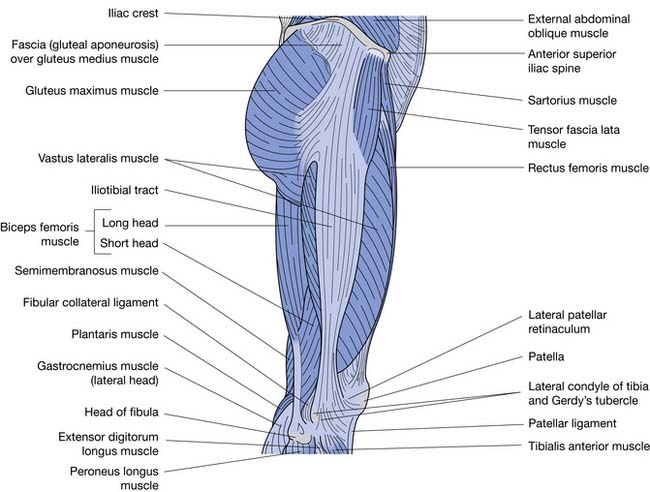
FIGURE 39-8 The iliotibial band is a strong fascial band that runs from the lateral hip to the lateral knee.
Although a bursa can become inflamed from sudden, direct trauma, it is far more common for a bursa to become gradually inflamed as a result of improper training techniques or abnormal biomechanics. In these cases, the bursal inflammation is not a primary process but rather secondary to muscle imbalance around the hip girdle or other abnormalities along the kinetic chain. The purpose of a bursa is to allow for low-friction gliding of soft tissues over a bony prominence. Any imbalance or dysfunction of the hip muscles can result in abnormal ITB motion and trochanteric bursitis. Patients with trochanteric bursitis can usually localize pain to the lateral hip. The pain is sometimes felt along the path of the ITB in the lateral thigh. On examination, there is tenderness to palpation directly over the greater trochanter or immediately posterior to it. Often weakness of the gluteus medius and the hip external rotators is seen, which can be detected with manual resistance testing.43 A typical hip girdle muscle imbalance seen in the setting of trochanteric bursitis includes tensor fascia lata tightness and gluteus maximus inhibition or weakness.
The modified Thomas test is an excellent physical examination maneuver to assess for inflexibility around the hip girdle. One should always check the function of the deep hip external rotators and muscle function along the entire kinetic chain, from the core region to the ankle. The function of the hip external rotators can be tested statically and dynamically. In runners and cyclists with ITB symptoms, it is important to perform a biomechanical assessment while the patient is running or riding. Occasionally an audible snap can be heard as the ITB rubs over the greater trochanter. This is sometimes referred to as lateral snapping hip syndrome. This condition is contrasted with the so-called internal snapping hip syndrome, in which a deeper, more medial snap is appreciated by the patient.55 Internal snapping hip is thought to be due to the iliopsoas tendon rubbing over the iliopectineal eminence or the femoral head. The same kinetic chain abnormalities that can cause ITB pain at the lateral hip can also cause pain and tenderness where the ITB passes over the lateral epicondyle of the femur, or at its insertion on to Gerdy’s tubercle. Symptoms are exacerbated by repetitive activities such as running or cycling.
Regardless of the location of symptoms related to ITB dysfunction, the treatment principles remain the same. The patient should reduce or eliminate the exacerbating activities. Ice is helpful for reducing pain and inflammation, and for facilitating a rehabilitation program. The exercise prescription should be based on the patient’s relevant biomechanical deficits, which are determined by the office examination and a functional examination of the patient while she or he is participating in activities. Merely providing standardized exercise handouts or prescribing nonspecific rehabilitation protocols can result in poor patient outcomes. One common example of prescribing nonspecific exercises for an ITB problem is to prescribe ITB stretches when the primary deficit is hip abductor weakness. Another common mistake is to focus on hip abductor strengthening if the most relevant biomechanical deficit is impaired eccentric control of the hip external rotators. Because all the hip girdle muscles originate on the pelvis, the core musculature must be able to adequately stabilize the pelvis for the hip girdle muscles to perform their functions during dynamic activities.
Disorders of the Hamstring Muscle Group
Strains of the thigh muscles are common in individuals participating in ballistic activities. The most commonly strained muscle group in the thigh is the hamstring group. The hamstring group includes the semimembranosus, semitendinosus, and short and long head of the biceps femoris. Hamstring strains most commonly occur with forceful eccentric contraction of the hamstring muscles, especially when the muscle is at a mechanical disadvantage near full flexion or full extension (Figure 39-9). The patient will usually be able to describe an acute overload mechanism. The hamstring pain can be reproduced by passive stretch of the muscle, by resistance testing of the muscle, and by direct palpation of the injured area. The strain can occur near the hamstring origin at the ischial tuberosity, in the belly of the muscle, or in the region of the distal musculotendinous junction. Severe hamstring strains will produce visible ecchymosis at and distal to the site of injury. A large muscle tear might produce a palpable defect. Imaging is usually not necessary to establish the diagnosis. If needed, MRI is the imaging modality of choice.78,136,149 Acute treatment consists of relative rest, ice, early gentle range of motion exercises, and gently progressive strengthening exercises as tolerated. Exercises should be progressed to higher weight and include more ballistic and sport-specific movements when tolerated. It is not uncommon for an acute hamstring strain to keep an individual from his or her usual athletic activities for 6 weeks or more.
< div class='tao-gold-member'>
Stay updated, free articles. Join our Telegram channel

Full access? Get Clinical Tree


